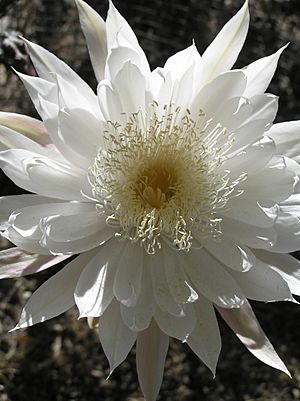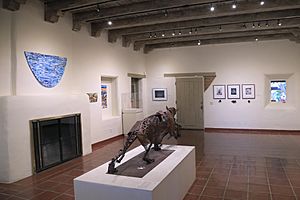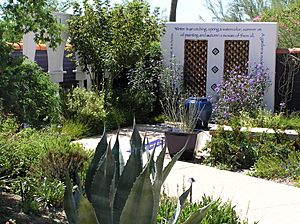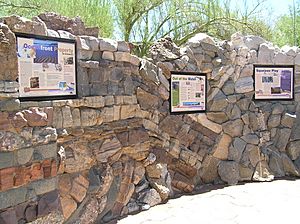Tohono Chul Park facts for kids
Quick facts for kids Tohono Chul |
|
|---|---|
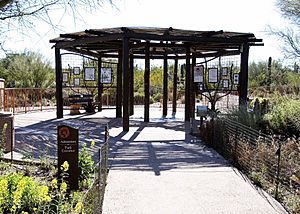
Entry Ramada
|
|
| Type | Botanical Garden and Museum |
| Location | Casas Adobes suburb of Tucson, Arizona, United States |
| Area | 49 acres (20 ha) |
| Created | 1985 |
| Administered by | private |
| Open | everyday except New Year's, July 4th, Thanksgiving, Christmas |
Tohono Chul is a special place in Tucson, Arizona, that combines a botanical garden, a nature preserve, and a cultural museum. It's like a living classroom where you can learn about the amazing Sonoran Desert. The name "Tohono Chul" means "desert corner" in the language of the Tohono O’odham people, who are native to this area.
This park helps people connect with the desert's nature, art, and culture. It also teaches us how to take good care of our natural world. The park covers 49 acres, which is about the size of 37 football fields! It's located in a natural desert area with beautiful views of the Santa Catalina Mountains.
Many animals call Tohono Chul home. About 38 types of birds live there all year, and 57 more visit during different seasons. You might even spot cool desert creatures like Gila monsters or bobcats roaming around. In 2008, Travel+Leisure Magazine even called Tohono Chul one of the best botanical gardens in the world!
Contents
The History of Tohono Chul Park
How the Park Land Was Used Before
Back in the 1920s, the area where Tohono Chul now stands was perfect for growing citrus fruits and date palms. A man named Maurice Reid owned a lot of land here. He planted many citrus trees and introduced black date palms and grapefruit to the property. Even after the land was divided into smaller pieces in 1931, many citrus groves remained.
In 1937, a polo player named John T. deBlois Wack bought 80 acres of this land for $16,000. Later that year, a Santa Fe-style house was built on the property. This house, which is now the park's Exhibit House, had thick adobe walls made from bricks created right there. Large Ponderosa pine logs from Mt. Lemmon were used for the living room beams.
The Bagnell Family and "Las Palmas"
The Wacks didn't spend much time in Tucson. After World War II, the property changed hands several times. In 1948, Colonel Robert Bagnell and his wife Eugenia Sullivan Bagnell bought the 80-acre parcel. They called their home "Las Palmas." Eugenia Bagnell gave some of the land to the Catholic Church for St. Odilia's Catholic Church, which you can still see today.
In 1963, Eugenia's son, John Sullivan, built another home on ten acres of the property. This house, known as the "West House," is now the Tohono Chul Garden Bistro and La Fuente Museum Shop. It has a traditional entrance hall and a beautiful courtyard with a fountain.
How Richard and Jean Wilson Created the Park
In 1966, Richard and Jean Wilson started buying parts of the desert land that would become Tohono Chul. They eventually owned 37 acres of the original Wack property. Richard Wilson was a geologist and a professor at the University of Arizona.
The Wilsons lived in the "West House" for eight years. They were often asked by developers to sell the land for building, but they always said no. Jean Wilson wanted to protect the land. She said, "I don't want it cemented over. I want to preserve it." When a road was widened nearby, Mr. Wilson even made sure every saguaro cactus was moved and replanted on their property!
In 1979, Jean Wilson opened a bookshop. After that, the Wilsons started planning their park. They began by simply making paths and labeling plants. In 1980, they were recognized for saving the desert green space and opening it to the public. They then created a non-profit group to help preserve the Sonoran Desert.
The Wilsons wanted to create a natural place where people could easily visit and learn about the desert. Tohono Chul Park officially opened as a 37-acre desert preserve on April 19, 1985. The Wilsons gave the property to the non-profit foundation in 1988. Later, in 1995, Tohono Chul bought another 11 acres, and in 1997, the Wilsons donated the land where their bookshop was, bringing the park to its current size of 49 acres.
What You Can See and Do at Tohono Chul
Tohono Chul has many interesting displays and exhibits that focus on the plants and culture of the desert. The park has over 150 types of shrubs and trees, 300 kinds of cacti and succulents, and 50 types of wildflowers. It also has the largest private collection of Night-blooming Cereus plants. Each summer, the park hosts "Bloom Night," a special event when many of these beautiful flowers are expected to open.
Outdoor Gardens and Exhibits
- Ethnobotanical Garden: This garden shows plants that native people of the Southwest used for food, medicine, and other daily needs. It also includes plants brought by European settlers.
- Riparian Habitat: This area looks like a natural stream-side environment, showing plants that grow near water in Arizona.
- Geology Wall: This display helps you understand the geological history of the nearby Santa Catalina Mountains.
- Saguaro Discovery Trail: Learn all about the saguaro cactus, its importance to the Tohono O’odham people, and its role in the Sonoran Desert.
- Sin Agua Garden: This used to be a parking lot but is now a demonstration of how to collect and use rainwater.
- Desert Living Courtyard: Another former parking lot, this area now has different garden designs that show how to use native and desert-adapted plants in your own yard.
- Sonoran Seasons Garden: Explore the five unique seasons of the Arizona Upland part of the Sonoran Desert.
- Desert Palm Oasis: This area recreates a hidden mountain canyon with native fan palms, like those found along the Gulf of California.
Indoor Art and Cultural Exhibits
Tohono Chul also has changing art and cultural exhibits indoors. These shows feature works by local artists and community groups of all ages. There are three different exhibit spaces used for various types of shows, from large group displays to smaller, individual artist exhibits.
See also
 In Spanish: Tohono Chul Park para niños
In Spanish: Tohono Chul Park para niños


